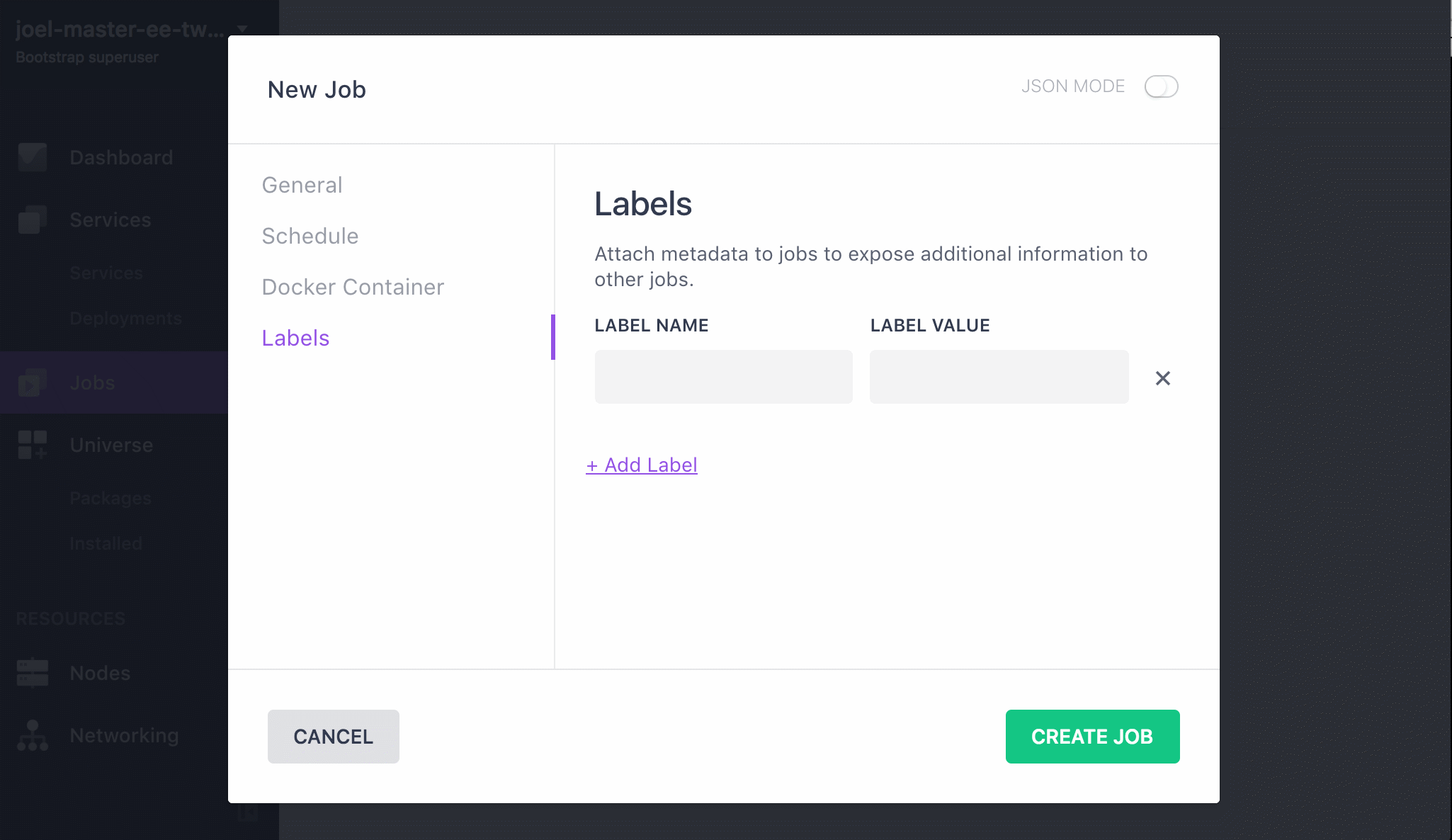This tutorial illustrates how labels can be defined using the DC/OS web interface and the Marathon HTTP API, and how information pertaining to applications and jobs that are running can be queried based on label value criteria.
When you deploy applications, containers, or jobs in a DC/OS cluster, you can associate a tag or label with your deployed components to track and report usage of the cluster by those components. For example, you may want to assign a cost center identifier or a customer number to a Mesos application and produce a summary report at the end of the month with usage metrics such as the amount of CPU and memory allocated to the applications by cost center or customer.
Assigning Labels to Applications and Tasks
You can attach labels to tasks from the DC/OS CLI. You can specify more than one label, but each label can have only one value.
DC/OS CLI
You can also specify label values in the labels parameter of your application definition.
vi myapp.json
{
"id": "myapp",
"cpus": 0.1,
"mem": 16.0,
"ports": [
0
],
"cmd": "/opt/mesosphere/bin/python3 -m http.server $PORT0",
"instances": 2,
"labels": {
"COST_CENTER": "0001"
}
}
Then, deploy from the DC/OS CLI:
dcos marathon app add <myapp>.json
Assigning Labels to Jobs
You can attach labels to jobs either via the Jobs tab of the DC/OS web interface or from the DC/OS CLI. You can specify more than one label, but each label can have only one value.
DC/OS Web Interface
From the DC/OS web interface, click the Jobs tab, then click on the name of the Job. This will take you to the individual Job page. Click Edit in the upper right corner. From the left hand side of the Edit Job page, select Labels.

Figure 1. Assign a job label
DC/OS CLI
You can also specify label values in the labels parameter of your job definition.
vi myjob.json
```json
{
"id": "my-job",
"description": "A job that sleeps",
"labels": {
"department": "marketing"
},
"run": {
"cmd": "sleep 1000",
"cpus": 0.01,
"mem": 32,
"disk": 0
}
}
```
Then, deploy from the DC/OS CLI:
dcos job add <myjob>.json
Displaying Label Information
Once your application is deployed and started, you can filter by label from the Services tab of the DC/OS UI. You can also use the Marathon HTTP API from the DC/OS CLI to query the running applications based on the label value criteria.
You can also use the Marathon HTTP API from the DC/OS CLI to query the running applications based on the label value criteria.
The code snippet below shows an HTTP request issued to the Marathon HTTP API. The curl program is used in this example to submit the HTTP GET request, but you can use any program that is able to send HTTP GET/PUT/DELETE requests. You can see the HTTP end-point is https://52.88.210.228/marathon/v2/apps and the parameters sent along with the HTTP request include the label criteria ?label=COST_CENTER==0001:
curl --insecure \
> https://52.88.210.228/marathon/v2/apps?label=COST_CENTER==0001 \
> | python -m json.tool | more
You can also specify multiple label criteria like so: ?label=COST_CENTER==0001,COST_CENTER==0002
In the example above, the response you receive will include only the applications that have a label COST_CENTER defined with a value of 0001. The resource metrics are also included, such as the number of CPU shares and the amount of memory allocated. At the bottom of the response, you can see the date/time this application was deployed, which can be used to compute the uptime for billing or charge-back purposes.
 DC/OS Documentation
DC/OS Documentation